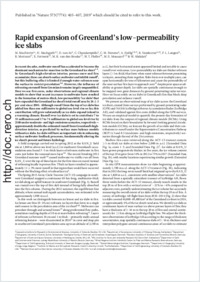Rapid expansion of Greenland’s low-permeability ice slabs
- MacFerrin, Mike Cooperative Institute for Research in Environmental Sciences, University of Colorado, Boulder, CO, USA
- Machguth, Horst Department of Geosciences, University of Fribourg, Switzerland - Department of Geography, University of Zurich, Switzerland
- As, Dirk van Geological Survey of Denmark and Greenland, Copenhagen, Denmark
- Charalampidis, C. Bavarian Academy of Sciences and Humanities, Munich, Germany
- Stevens, C. M. Department of Earth and Space Sciences, University of Washington, Seattle, WA, USA
- Heilig, A. WSL Institute for Snow and Avalanche Research SLF, Davos Dorf, Switzerland - Department of Earth and Environmental Sciences, Ludwig-Maximilians-University of Munich, Germany - Alfred Wegener Institute Helmholtz-Centre for Polar and Marine Research, Bremerhaven, Germany
- Vandecrux, B. Geological Survey of Denmark and Greenland, Copenhagen, Denmark - Department of Civil Engineering, Technical University of Denmark, Kongens Lyngby, Denmark
- Langen, P. L. Danish Meteorological Institute, Copenhagen, Denmark
- Mottram, R. Danish Meteorological Institute, Copenhagen, Denmark
- Fettweis, Xavier Department of Geography, University of Liège, Belgium
- Broeke, Michiel R. van den Institute for Marine and Atmospheric Research, Utrecht University, Utrecht, The Netherlands
- Pfeffer, W. T. Department of Civil Engineering, University of Colorado, Boulder, CO, USA
- Moussavi, M. S. Cooperative Institute for Research in Environmental Sciences, University of Colorado, Boulder, CO, USA - National Snow and Ice Data Center, University of Colorado, Boulder, CO, USA
- Abdalati, W. Cooperative Institute for Research in Environmental Sciences, University of Colorado, Boulder, CO, USA
-
01.09.2019
Published in:
- Nature. - 2019, vol. 573, no. 7774, p. 403–407
English
In recent decades, meltwater runoff has accelerated to become the dominant mechanism for mass loss in the Greenland ice sheet1,2,3. In Greenland’s high- elevation interior, porous snow and firn accumulate; these can absorb surface meltwater and inhibit runoff4, but this buffering effect is limited if enough water refreezes near the surface to restrict percolation5,6. However, the influence of refreezing on runoff from Greenland remains largely unquantified. Here we use firn cores, radar observations and regional climate models to show that recent increases in meltwater have resulted in the formation of metres-thick, low-permeability ‘ice slabs’ that have expanded the Greenland ice sheet’s total runoff area by 26 ± 3 per cent since 2001. Although runoff from the top of ice slabs has added less than one millimetre to global sea-level rise so far, this contribution will grow substantially as ice slabs expand inland in a warming climate. Runoff over ice slabs is set to contribute 7 to 33 millimetres and 17 to 74 millimetres to global sea-level rise by 2100 under moderate- and high-emissions scenarios, respectively—approximately double the estimated runoff from Greenland’s high-elevation interior, as predicted by surface mass balance models without ice slabs. Ice slabs will have an important role in enhancing surface meltwater feedback processes, fundamentally altering the ice sheet’s present and future hydrology.
- Faculty
- Faculté des sciences et de médecine
- Department
- Département de Géosciences
- Language
-
- English
- Classification
- Hydrology
- Other electronic version
- License
- License undefined
- Identifiers
-
- RERO DOC 327417
- DOI 10.1038/s41586-019-1550-3
- Persistent URL
- https://folia.unifr.ch/unifr/documents/308035
Statistics
Document views: 101
File downloads:
- mac_reg.pdf: 193
